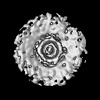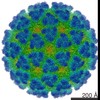+Search query
-Structure paper
| Title | fate of Chikungunya virus replication organelles. |
|---|---|
| Journal, issue, pages | J Virol, Vol. 98, Issue 7, Page e0036824, Year 2024 |
| Publish date | Jul 23, 2024 |
 Authors Authors | Justine Girard / Olivier Le Bihan / Joséphine Lai-Kee-Him / Maria Girleanu / Eric Bernard / Cedric Castellarin / Matthew Chee / Aymeric Neyret / Danièle Spehner / Xavier Holy / Anne-Laure Favier / Laurence Briant / Patrick Bron /  |
| PubMed Abstract | Chikungunya virus (CHIKV) is a mosquito-borne pathogen responsible for an acute musculoskeletal disease in humans. Replication of the viral RNA genome occurs in specialized membranous replication ...Chikungunya virus (CHIKV) is a mosquito-borne pathogen responsible for an acute musculoskeletal disease in humans. Replication of the viral RNA genome occurs in specialized membranous replication organelles (ROs) or spherules, which contain the viral replication complex. Initially generated by RNA synthesis-associated plasma membrane deformation, alphavirus ROs are generally rapidly endocytosed to produce type I cytopathic vacuoles (CPV-I), from which nascent RNAs are extruded for cytoplasmic translation. By contrast, CHIKV ROs are poorly internalized, raising the question of their fate and functionality at the late stage of infection. Here, using cryogenic-electron microscopy approaches, we investigate the outcome of CHIKV ROs and associated replication machinery in infected human cells. We evidence the late persistence of CHIKV ROs at the plasma membrane with a crowned protein complex at the spherule neck similar to the recently resolved replication complex. The unexpectedly heterogeneous and large diameter of these compartments suggests a continuous, dynamic growth of these organelles beyond the replication of a single RNA genome. Ultrastructural analysis of surrounding cytoplasmic regions supports that outgrown CHIKV ROs remain dynamically active in viral RNA synthesis and export to the cell cytosol for protein translation. Interestingly, rare ROs with a homogeneous diameter are also marginally internalized in CPV-I near honeycomb-like arrangements of unknown function, which are absent in uninfected controls, thereby suggesting a temporal regulation of this internalization. Altogether, this study sheds new light on the dynamic pattern of CHIKV ROs and associated viral replication at the interface with cell membranes in infected cells.IMPORTANCEThe Chikungunya virus (CHIKV) is a positive-stranded RNA virus that requires specialized membranous replication organelles (ROs) for its genome replication. Our knowledge of this viral cycle stage is still incomplete, notably regarding the fate and functional dynamics of CHIKV ROs in infected cells. Here, we show that CHIKV ROs are maintained at the plasma membrane beyond the first viral cycle, continuing to grow and be dynamically active both in viral RNA replication and in its export to the cell cytosol, where translation occurs in proximity to ROs. This contrasts with the homogeneous diameter of ROs during internalization in cytoplasmic vacuoles, which are often associated with honeycomb-like arrangements of unknown function, suggesting a regulated mechanism. This study sheds new light on the dynamics and fate of CHIKV ROs in human cells and, consequently, on our understanding of the Chikungunya viral cycle. |
 External links External links |  J Virol / J Virol /  PubMed:38940586 / PubMed:38940586 /  PubMed Central PubMed Central |
| Methods | EM (subtomogram averaging) |
| Resolution | 31.0 Å |
| Structure data |  EMDB-50321: sub-tomogram averaging map of CHIKV replication organelle connection to the plasma membrane |
| Source |
|
 Movie
Movie Controller
Controller Structure viewers
Structure viewers About Yorodumi Papers
About Yorodumi Papers




 Chikungunya virus
Chikungunya virus